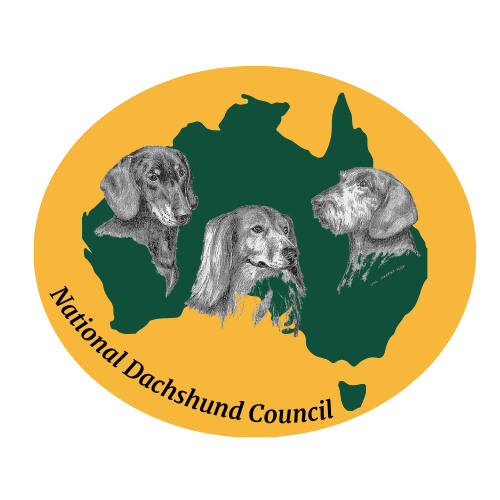ANKC Breed Standard & Standard Extension
One dog, three sizes, three coats = nine varieties

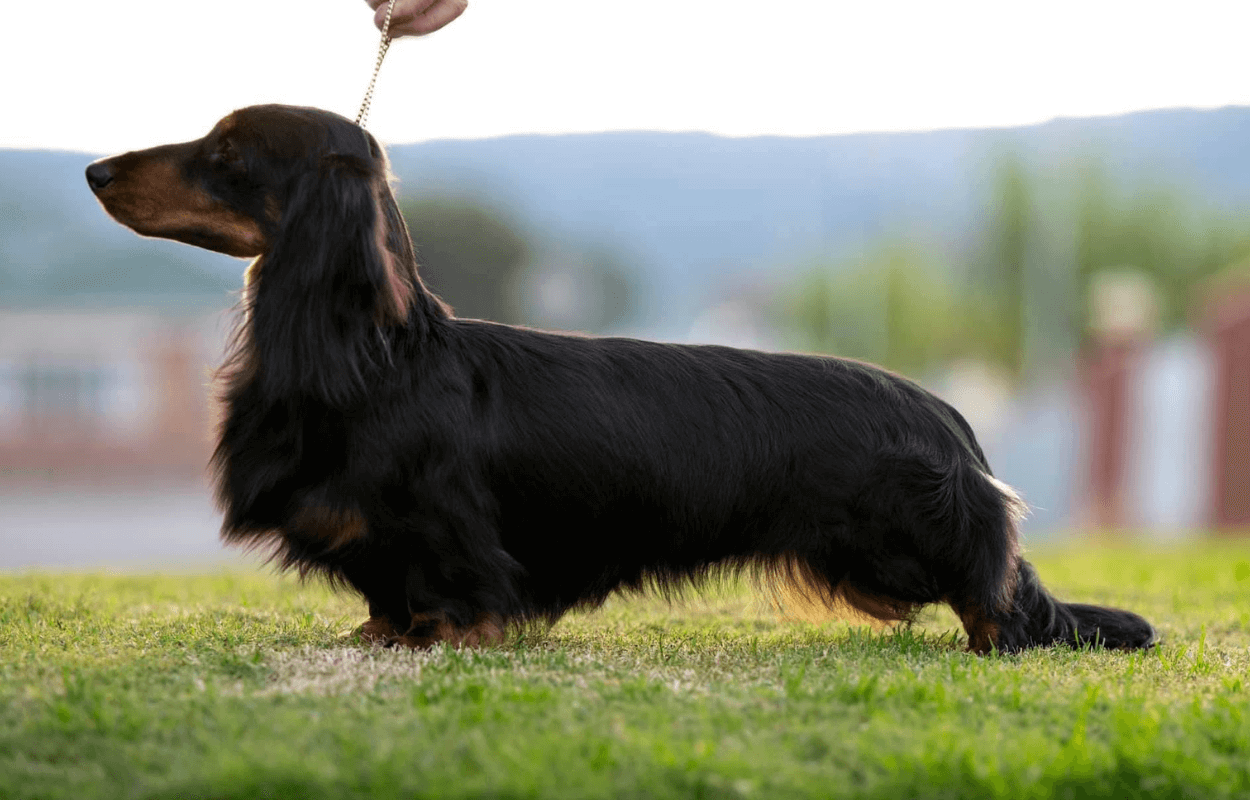
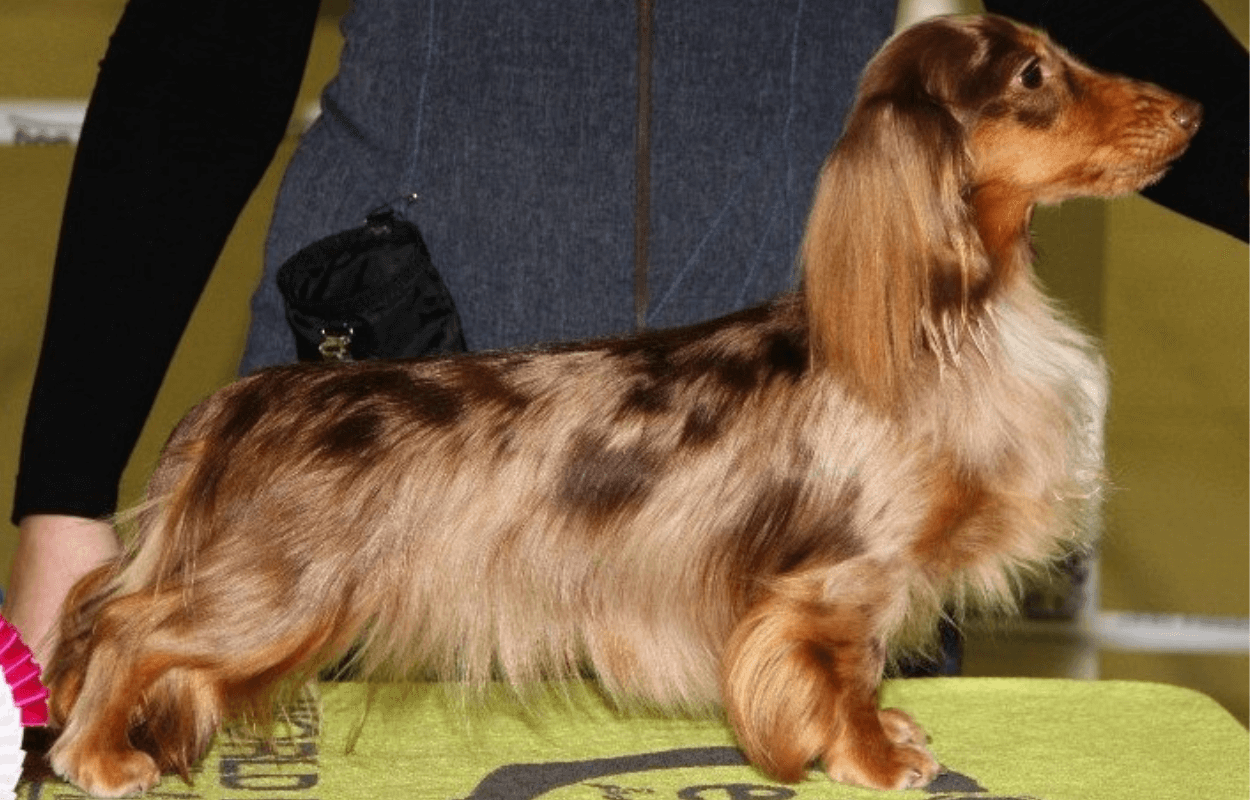
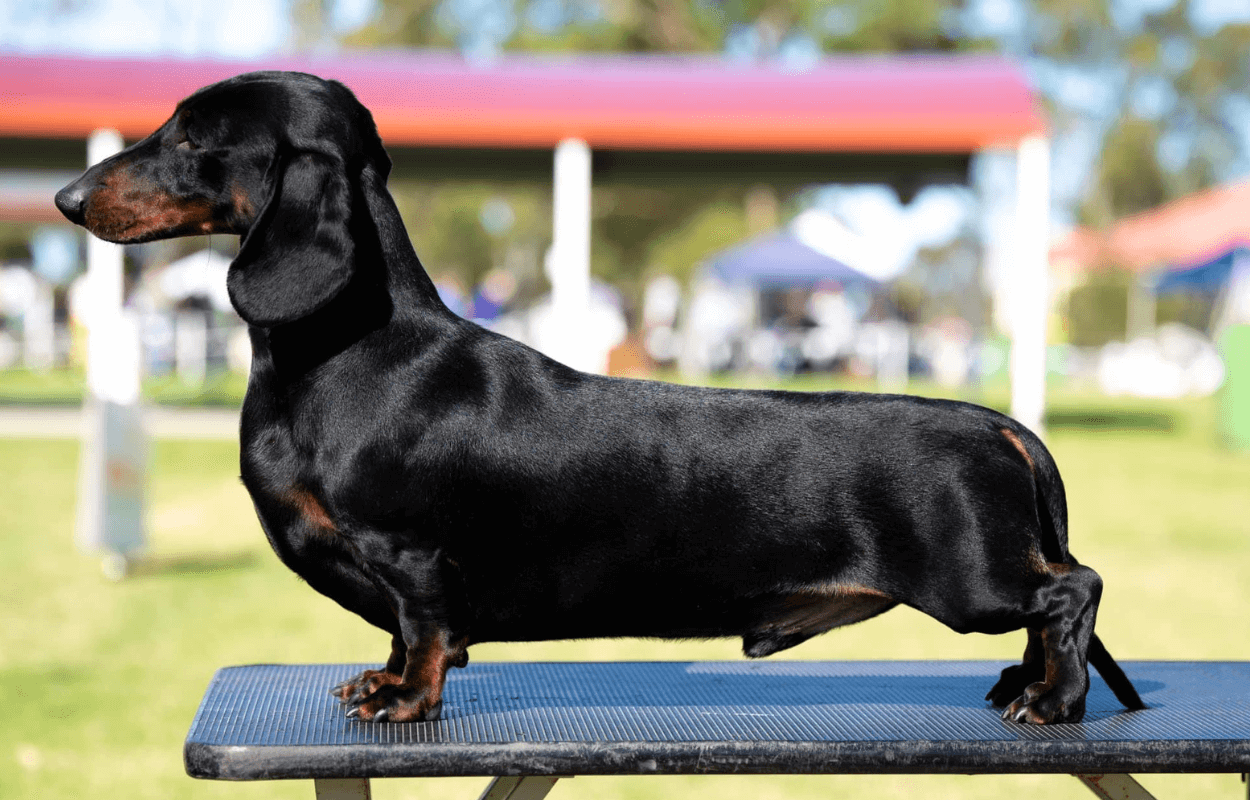
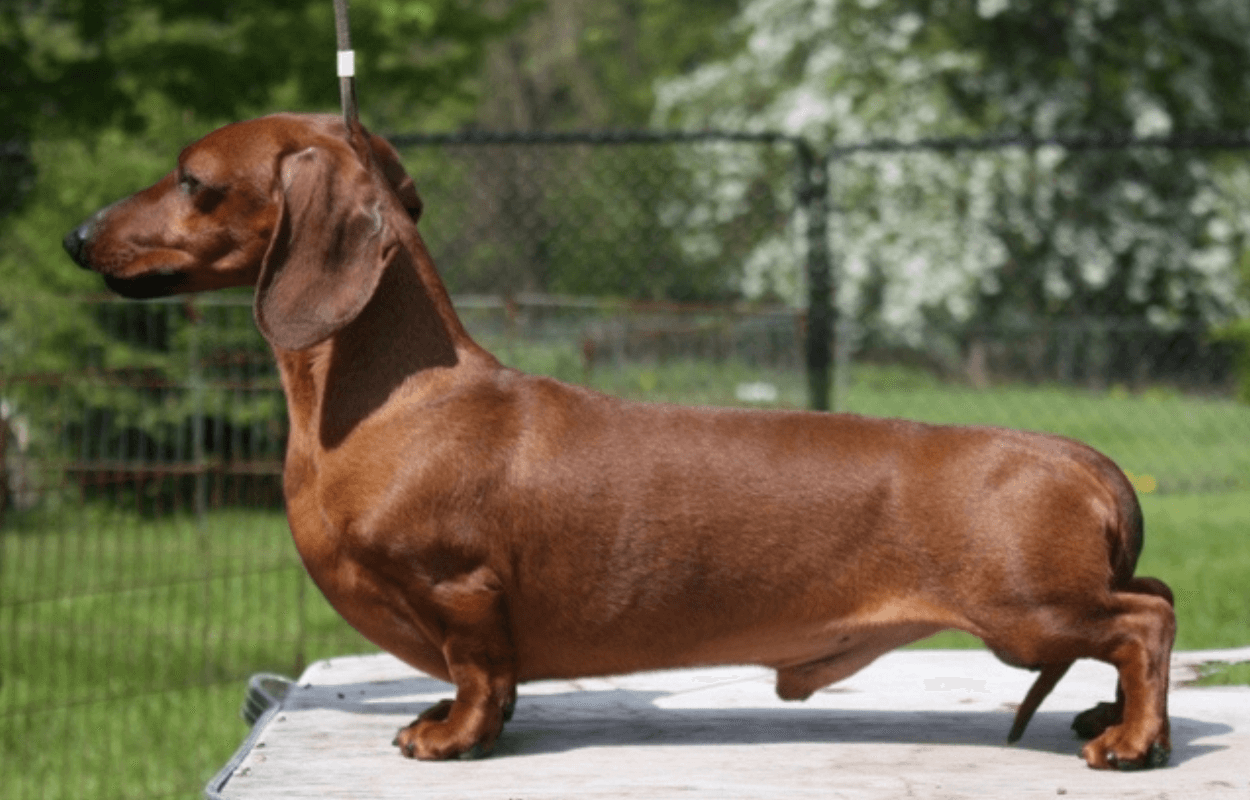
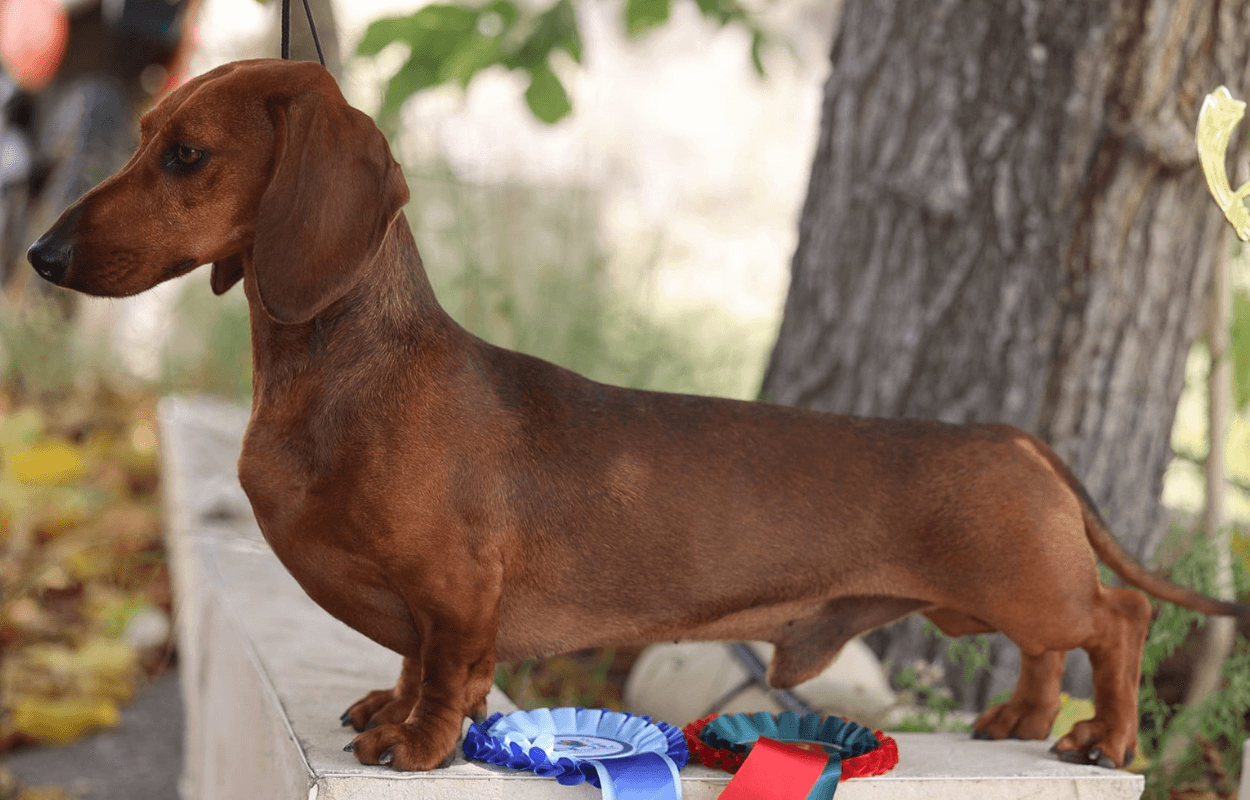
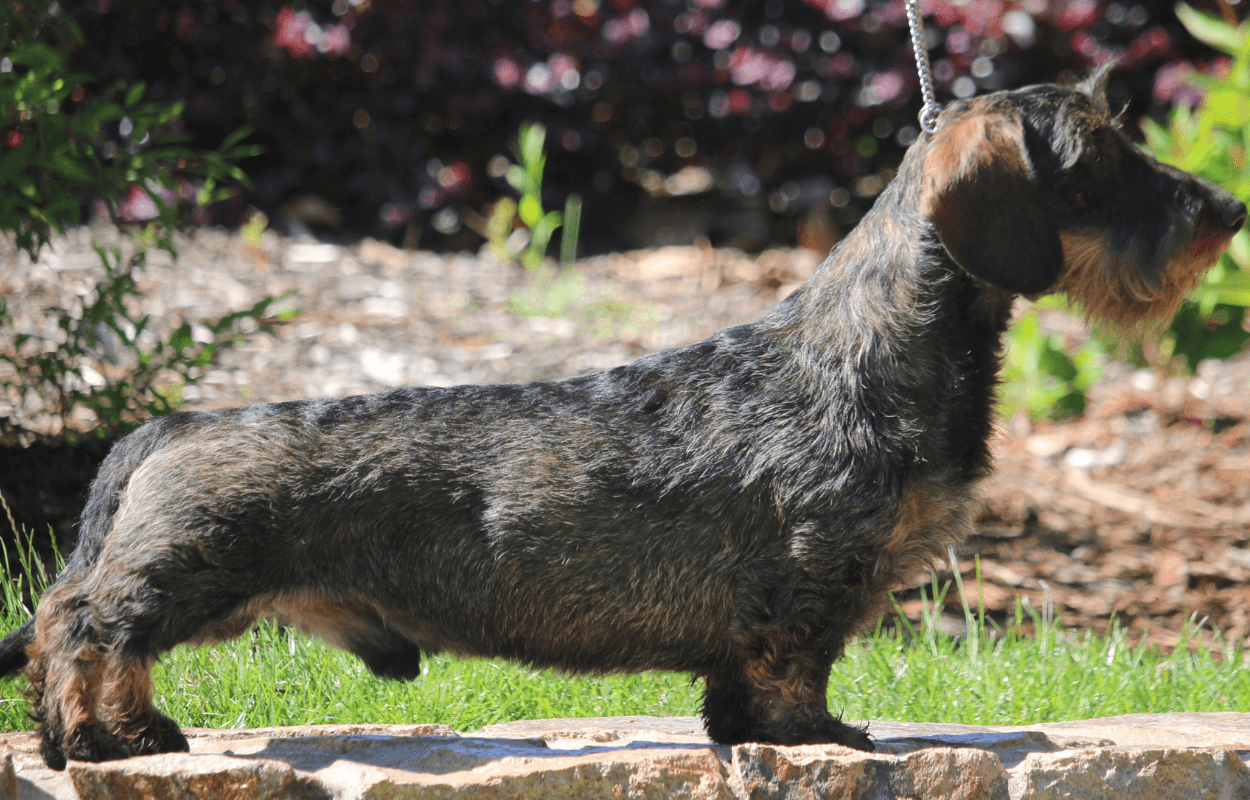
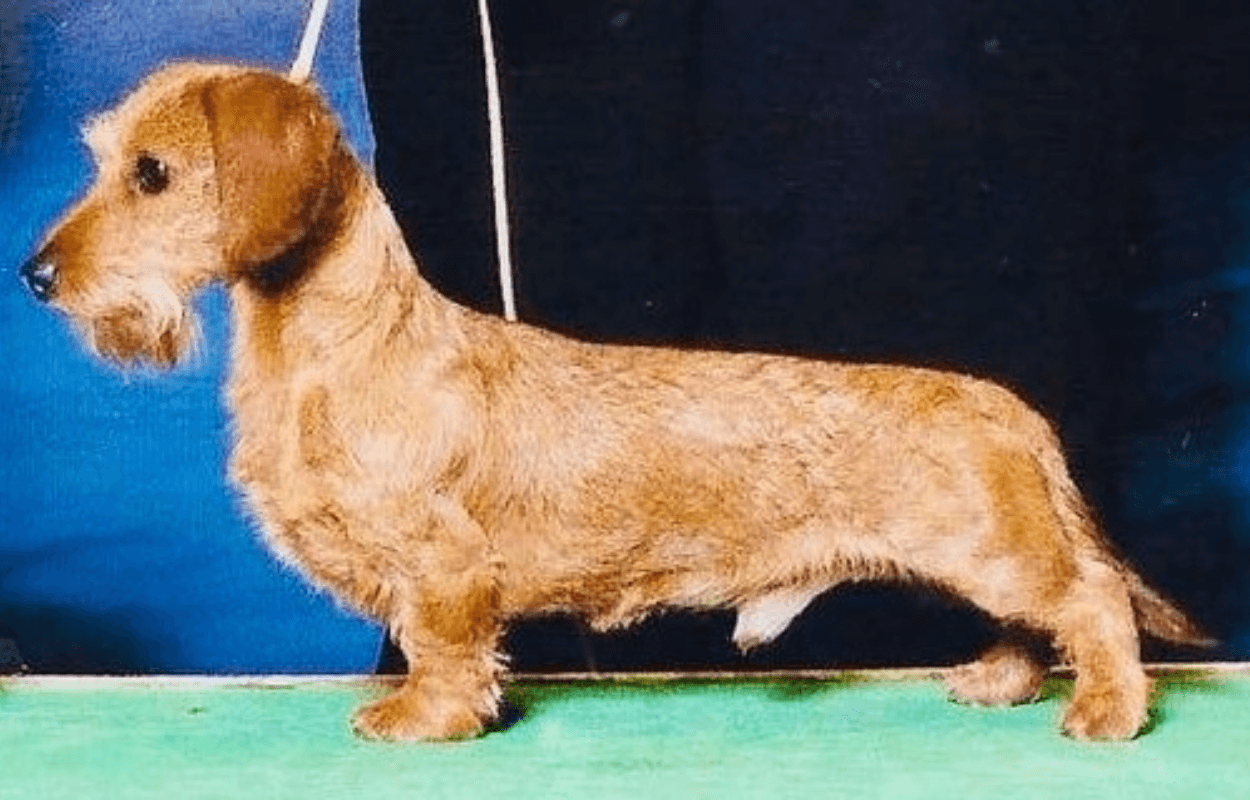
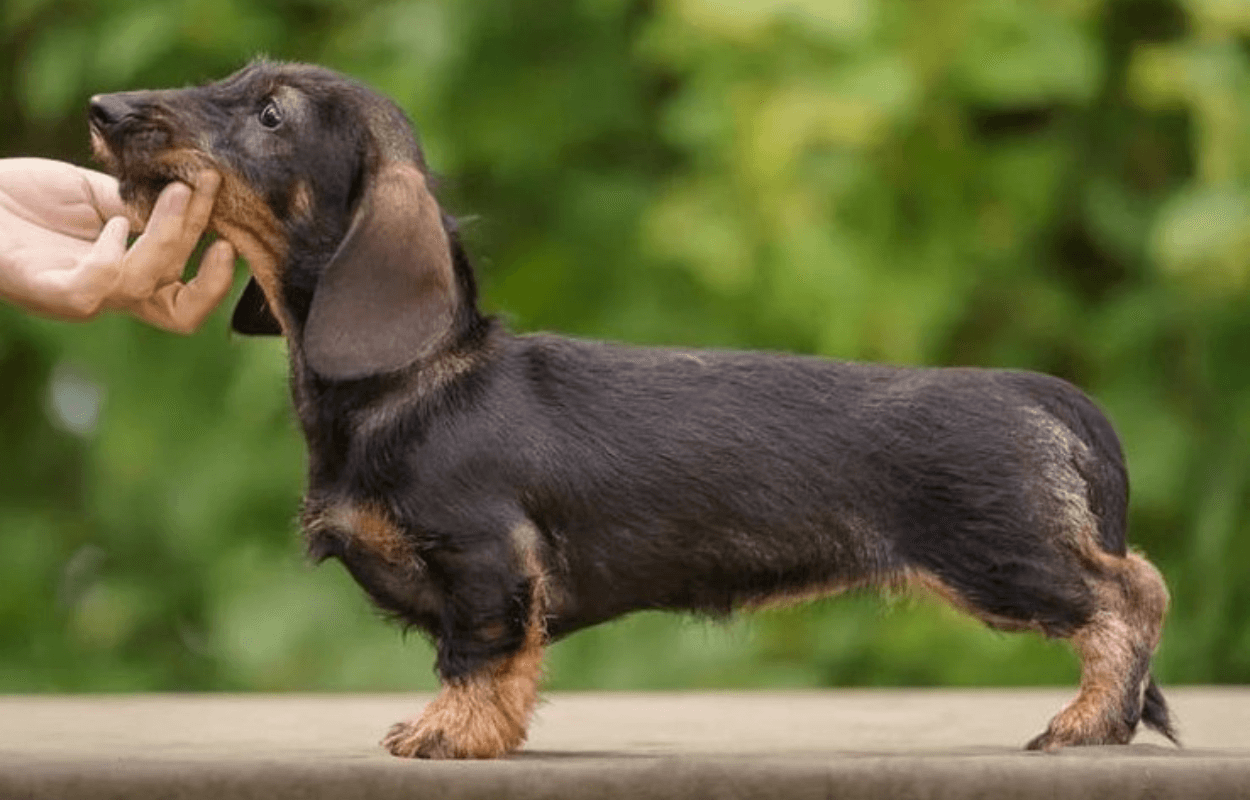
The National Dachshund Council, in accordance with the wishes of member clubs, and approved by their members, applied to the Australian National Kennel Council to change from the pre-1987 Kennel Club (UK) Standard to the current Kennel Club (UK) Standard in 2009. Recently, the ANKC recognised the Kaninchen Dachshund (Rabbit Dog) breed, which is judged under the FCI Standard.
| Kaninchen | Miniature | Standard | N/A | |
|---|---|---|---|---|
| The Australian Breed Standard is founded on which Breed Standard? | European FCI Standard | UK Standard | UK Standard | American Standard |
| General Appearance | Low, short legged, elongated but compact build, very muscular with cheeky, challenging head carriage and alert facial expression. His general appearance is typical of his sex. In spite of his legs being short in relation to the long body, he is very mobile and lithe. With the distance above ground level of about one third of the height at withers, the body length should be in harmonious relation to height at withers, about 1 to 1,7 – 1,8. | Moderately long and low with no exaggeration; compact, well muscled body, with enough ground clearance to allow free movement. Height at the withers should be half the length of the body, measured from breastbone to the rear of thigh. Bold, defiant carriage of head and intelligent expression. | Moderately long and low with no exaggeration; compact, well muscled body, with enough ground clearance to allow free movement. Height at the withers should be half the length of the body, measured from breastbone to the rear of thigh. Bold, defiant carriage of head and intelligent expression. | Low to ground, long in body and short of leg, with robust muscular development; the skin is elastic and pliable without excessive wrinkling. Appearing neither crippled, awkward, nor cramped in his capacity for movement, the Dachshund is well balanced with bold and confident head carriage and intelligent, alert facial expression. His hunting spirit, good nose, loud tongue and distinctive build make him well-suited for below-ground work and for beating the bush. His keen nose gives him an advantage over most other breeds for trailing. NOTE: Inasmuch as the Dachshund is a hunting dog, scars from honourable wounds shall not be considered a fault. |
| Characteristics | Intelligent, lively, courageous to the point of rashness, obedient. Especially suited to going to ground because of low build, very strong forequarters, and forelegs, long strong jaw, and immense power of bite and hold. Excellent nose, persevering hunter and trackers. Essential that functional build is retained to ensure working ability. | Intelligent, lively, courageous to the point of rashness, obedient. Especially suited to going to ground because of low build, very strong forequarters, and forelegs, long strong jaw, and immense power of bite and hold. Excellent nose, persevering hunter and trackers. Essential that functional build is retained to ensure working ability. | Special Characteristics of the Three Coat Varieties – The Dachshund is bred with three varieties of coat: (1) Smooth; (2) Wirehaired; (3) Longhaired and is shown in two sizes, standard and miniature. All three varieties and both sizes must conform to the characteristics (already) specified. | |
| Temperament | Friendly by nature, neither nervous nor aggressive, with even temperament. Passionate, persevering and fast hunting dog with an excellent nose. | Faithful, versatile and good tempered. | Faithful, versatile and good tempered. | The Dachshund is clever, lively and courageous to the point of rashness, persevering in above- and below-ground work, with all the senses well developed. Any display of shyness is a serious fault. |
| Head and Skull | Elongated as seen from above and in profile. Tapering uniformly towards the nose leather yet not pointed. Superciliary ridges clearly defined. Nasal cartilage and bridge of nose, long and narrow. CRANIAL REGION: Skull: Rather flat, gradually merging with the slightly arched nasal bridge. Stop: Only indicated. FACIAL REGION: Nose: Leather well developed. Muzzle: Long, sufficiently broad and strong. Can be opened wide, split to level of eye. Lips: Taut fitting, covering the lower jaw well. | Long, appearing conical when seen from above; and from a side view tapering uniformly to the tip of the muzzle. Skull only slightly arched. Neither too broad nor too narrow, sloping gradually without a prominent stop into a slightly arched muzzle. The length from the back of the skull to the eyes should be the same as from the eyes to the end of the muzzle. In Wirehaired particularly, ridges over the eyes strongly prominent, giving appearance of a slightly broader skull. Lips well stretched, neatly covering the lower jaw. Strong jaw bones, not too square or snipy, but opening wide. | Long, appearing conical when seen from above; and from a side view tapering uniformly to the tip of the muzzle. Skull only slightly arched. Neither too broad nor too narrow, sloping gradually without a prominent stop into a slightly arched muzzle. The length from the back of the skull to the eyes should be the same as from the eyes to the end of the muzzle. In Wirehaired particularly, ridges over the eyes strongly prominent, giving appearance of a slightly broader skull. Lips well stretched, neatly covering the lower jaw. Strong jaw bones, not too square or snipy, but opening wide. | Viewed from above or from the side, the head tapers uniformly to the tip of the nose. The eyes are of medium size, almond-shaped and dark-rimmed, with an energetic, pleasant expression; not piercing; very dark in colour. The bridge bones over the eyes are strongly prominent. The skull is slightly arched, neither too broad nor too narrow, and slopes gradually with little perceptible stop into the finely-formed, slightly arched muzzle, giving a Roman appearance. Lips are tightly stretched, well covering the lower jaw. Nostrils well open. Jaws opening wide and hinged well back of the eyes, with strongly developed bones and teeth. |
| Eyes | Medium size, oval, set well apart, with clear energetic yet friendly expression. Not piercing. Colour bright, dark reddish brown to blackish brown in all coat colours. Wall, fish or pearl eyes in dapple dogs are not desired but may be tolerated. | Medium size, almond shaped, set obliquely. Dark except in Chocolates, where they can be lighter. In Dapples, one or both wall eyes are permissible. | Medium size, almond shaped, set obliquely. Dark except in Chocolates, where they can be lighter. In Dapples, one or both wall eyes are permissible. | Wall eyes, except in the case of dappled dogs, are a serious fault. |
| Ears | Set on high, not too far forward. Sufficiently long but not exaggerated. Rounded, not narrow, pointed or folded. Mobile with front edge lying close to cheek. | Set high and not too far forward. Broad, of moderate length and well rounded (not narrow, pointed or folded). Forward edge touching the cheek. Mobile, and when at attention, the back of the ear is directed forward and outward. | Set high and not too far forward. Broad, of moderate length and well rounded (not narrow, pointed or folded). Forward edge touching the cheek. Mobile, and when at attention, the back of the ear is directed forward and outward. | The ears are set near the top of the head, not too far forward, of moderate length, rounded, not narrow, pointed, or folded. Their carriage, when animated, is with the forward edge just touching the cheek so that the ears frame the face. |
| Mouth | Well developed upper and lower jaw. Scissor bite, even and closing firmly. Ideally, complete set of 42 teeth according to requirements for a dog’s mouth with strong Canines exactly fitting into each other. | Teeth must be strongly developed; the powerful canine teeth fitting closely. Jaws strong, with a perfect, regular and complete scissor bite; i.e. the upper teeth closely overlapping the lower teeth and set square to the jaws. Complete dentition important. | Teeth must be strongly developed; the powerful canine teeth fitting closely. Jaws strong, with a perfect, regular and complete scissor bite; i.e. the upper teeth closely overlapping the lower teeth and set square to the jaws. Complete dentition important. | Powerful canine teeth; teeth fit closely together in a scissors bite. An even bite is a minor fault. Any other deviation is a serious fault. |
| Neck | Sufficiently long, muscular. Tight fitting skin on throat. Lightly arched nape of neck, carried freely and high. | Long, muscular, clean with no dewlap, slightly arched, running in graceful lines into shoulders, carried proudly forward. | Long, muscular, clean with no dewlap, slightly arched, running in graceful lines into shoulders, carried proudly forward. | Long, muscular, clean-cut, without dewlap, slightly arched in the nape, flowing gracefully into the shoulders without creating the impression of a right angle. |
| Forequarters | General: Strongly muscled, well angulated. Seen from front, clean front legs, standing straight with good strength of bone; feet pointing straight forward. Shoulders: Pliant muscles. Long sloping shoulder blade, fitting close to chest. Upper arm: Equal in length to shoulder blade, set almost at right angle to same. Strong boned and well muscled, close fitting to ribs but free in movement. Elbows: Turning neither in nor out. Forearm: Short, yet so long that the dog’s distance from the ground is about one third of its height at withers. As straight as possible. Pastern joints: Slightly closer together than the shoulder joints. Pastern: Seen from the side, should be neither steep nor noticeably inclined forward. | For effective underground work, the front must be strong, deep, long and cleanly muscled. Forequarters in detail: Chest – The breast-bone is strongly prominent in front so that on either side a depression or dimple appears. When viewed from the front, the thorax appears oval and extends downward to the mid-point of the forearm. The enclosing structure of the well-sprung ribs appears full and oval to allow, by its ample capacity, complete development of heart and lungs. The keel merges gradually into the line of the abdomen and extends well beyond the front legs. Viewed in profile, the lowest point of the breast line is covered by the front leg. Shoulder blades – Long, broad, well laid back and firmly placed upon the fully developed thorax, closely fitted at the withers, furnished with hard yet pliable muscles. Upper Arm – Ideally the same length as the shoulder blade and at right angles to the latter, strong of bone and hard of muscle, lying close to the ribs, with elbows close to the body, yet capable of free movement. Forearm – Short; supplied with hard yet pliable muscles on the front and outside, with tightly stretched tendons on the inside and at the back, slightly curved inwards. The joints between the forearms and the feet (wrists) are closer together than the shoulder joints, so that the front does not appear absolutely straight. The inclined shoulder blades, upper arms and curved forearms form parentheses that enclose the ribcage, creating the correct “wraparound front.” Knuckling over is a disqualifying fault. | For effective underground work, the front must be strong, deep, long and cleanly muscled. Forequarters in detail: Chest – The breast-bone is strongly prominent in front so that on either side a depression or dimple appears. When viewed from the front, the thorax appears oval and extends downward to the mid-point of the forearm. The enclosing structure of the well-sprung ribs appears full and oval to allow, by its ample capacity, complete development of heart and lungs. The keel merges gradually into the line of the abdomen and extends well beyond the front legs. Viewed in profile, the lowest point of the breast line is covered by the front leg. Shoulder blades – Long, broad, well laid back and firmly placed upon the fully developed thorax, closely fitted at the withers, furnished with hard yet pliable muscles. Upper Arm – Ideally the same length as the shoulder blade and at right angles to the latter, strong of bone and hard of muscle, lying close to the ribs, with elbows close to the body, yet capable of free movement. Forearm – Short; supplied with hard yet pliable muscles on the front and outside, with tightly stretched tendons on the inside and at the back, slightly curved inwards. The joints between the forearms and the feet (wrists) are closer together than the shoulder joints, so that the front does not appear absolutely straight. The inclined shoulder blades, upper arms and curved forearms form parentheses that enclose the ribcage, creating the correct “wraparound front.” Knuckling over is a disqualifying fault. | Shoulder blades long, broad and placed firmly and obliquely (45 degrees to the horizontal) upon very robust rib cage. Upper arm the same length as shoulder blade, set at 90 degrees to it, very strong and covered with hard supple muscles. Upper arm lies close to the ribs but able to move freely. Forearm short and strong in bone, inclining slightly inwards; when seen in profile moderately straight, must not bend forward or knuckle over, which indicates unsoundness. Correctly placed foreleg should cover the lowest point of the keel. |
| Kaninchen – FCI Standard | Miniature – Aust. / UK Standard | Standard – Aust. / UK Standard | N/A – American Standard | |
| Body | Upper line: Blending harmoniously from neck to slightly sloping croup. Withers: Pronounced. Back: Behind the high withers, topline running from the thoracic vertebrae straight or slightly inclined to the rear. Firm and well muscled. Loins: Strongly muscled. Sufficiently long. Croup: Broad and sufficiently long. Slightly sloping. Chest: Sternum well developed and so prominent that slight depressions appear on either side. The ribcage, seen from the front, is oval. Seen from above and the side, it is roomy, giving plenty of space for the heart and lung development. Ribs carried well back. With correct length and angulation of shoulder blade and upper arm, the front leg covers the lowest point of the sternal line in profile. Underline and Belly: Slight tuck up. Skin: Tight fitting. | Moderately long and full muscled. Sloping shoulders, back reasonably level, blending harmoniously between withers and slightly arched loin. Loin short and strong. Breastbone strong and so prominent that a depression appears on either side of it in front. When viewed from the front, thorax full and oval; when viewed from side or above, full volumed so allowing by its ample capacity complete development of the heart and lungs. Well ribbed up, underline gradually merging into the line of the abdomen. Body sufficiently clear of the ground to allow free movement. | Moderately long and full muscled. Sloping shoulders, back reasonably level, blending harmoniously between withers and slightly arched loin. Loin short and strong. Breastbone strong and so prominent that a depression appears on either side of it in front. When viewed from the front, thorax full and oval; when viewed from side or above, full volumed so allowing by its ample capacity complete development of the heart and lungs. Well ribbed up, underline gradually merging into the line of the abdomen. Body sufficiently clear of the ground to allow free movement. | The trunk is long and fully muscled. When viewed in profile, the back lies in the straightest possible line between the withers and the short, very slightly arched loin. A body that hangs loosely between the shoulders is a serious fault. Abdomen – Slightly drawn up. |
| Hindquarters | General: Strongly muscled, in correct proportion to forequarters. Strong angulation of stifles and hock joints. Hindlegs parallel standing neither close nor wide apart. Upper thigh: Should be of good length and well muscled. Stifle (joint): Broad and strong with pronounced angulation. Lower thigh: Short, almost at right angle to upper thigh. Well muscled. Hock joint: Clean with strong tendons. Hock: Relatively long, mobile towards lower thigh. Lightly curved forward. | Rump full, broad and strong pliant muscles. Croup long, full, robustly muscled, only slightly sloping towards the tail. Pelvis strong, set obliquely and not too short. Upper thigh set at right angles to pelvis, strong and of good length. Lower thigh short, set at right angles to upper thigh and well muscled. Legs when seen from behind set well apart, straight and parallel. | Rump full, broad and strong pliant muscles. Croup long, full, robustly muscled, only slightly sloping towards the tail. Pelvis strong, set obliquely and not too short. Upper thigh set at right angles to pelvis, strong and of good length. Lower thigh short, set at right angles to upper thigh and well muscled. Legs when seen from behind set well apart, straight and parallel. | Strong and cleanly muscled. The pelvis, the thigh, the second thigh, and the rear pastern are ideally the same length and give the appearance of a series of right angles. From the rear, the thighs are strong and powerful. The legs turn neither in nor out. Rear pasterns – Short and strong, perpendicular to the second thigh bone. When viewed from behind, they are upright and parallel. Feet – Hind Paws – Smaller than the front paws with four compactly closed and arched toes with tough, thick pads. The entire foot points straight ahead and is balanced equally on the ball and not merely on the toes. Rear dewclaws should be removed. Croup – Long, rounded and full, sinking slightly toward the tail. Tail – Set in continuation of the spine, extending without kinks, twists, or pronounced curvature, and not carried too gaily. |
| Feet | Front feet: Toes close together, well arched with strong, resistant, well cushioned pads and short strong nails. The fifth toe has no function but must not be removed. Hind feet: Four close knit toes, well arched. Standing firmly on strong pads. | Front feet full, broad, deep, close knit, straight or very slightly turned out. Hind feet smaller and narrower. Toes close together with a decided arch to each toe, strong regularly placed nails, thick and firm pads. Dog must stand true, i.e. equally on all parts of the foot. | Front feet full, broad, deep, close knit, straight or very slightly turned out. Hind feet smaller and narrower. Toes close together with a decided arch to each toe, strong regularly placed nails, thick and firm pads. Dog must stand true, i.e. equally on all parts of the foot. | Front paws are full, tight, compact, with well-arched toes and tough, thick pads. They may be equally inclined a trifle outward. There are five toes, four in use, close together with a pronounced arch and strong, short nails. Front dewclaws may be removed. |
| Tail | Not set on too high, carried in continuation of topline. A slight curve in the last third of the tail is permitted. | Continues line of the spine, but slightly curved, without kinks or twists, not carried too high, or touching the ground when at rest. | Continues line of the spine, but slightly curved, without kinks or twists, not carried too high, or touching the ground when at rest. | See coat section |
| Gait/Movement | Movement should be ground covering, flowing and energetic, with far reaching front strides without much lift, and strong rear drive movement should produce slightly springy transmission to backline. Tail should be carried in harmonious continuation of backline, slightly sloping. Front and hindlegs have parallel movement. | Should be free and flowing. Stride should be long with the drive coming from the hindquarters when viewed from the side. Viewed from in front or behind, the legs and feet should move parallel to each other with the distance apart being the width of the shoulder and hip joints respectively. | Should be free and flowing. Stride should be long with the drive coming from the hindquarters when viewed from the side. Viewed from in front or behind, the legs and feet should move parallel to each other with the distance apart being the width of the shoulder and hip joints respectively. | Fluid and smooth. Forelegs reach well forward, without much lift, in unison with the driving action of hind legs. The correct shoulder assembly and well-fitted elbows allow the long, free stride in front. Viewed from the front, the legs do not move in exact parallel planes, but incline slightly inward. Hind legs drive on a line with the forelegs, with hock joints and rear pasterns (metatarsus) turning neither in nor out. The propulsion of the hind leg depends on the dog’s ability to carry the hind leg to complete extension. Viewed in profile, the forward reach of the hind leg equals the rear extension. The thrust of correct movement is seen when the rear pads are clearly exposed during rear extension. Rear feet do not reach upward toward the abdomen and there is no appearance of walking on the rear pasterns. Feet must travel parallel to the line of motion with no tendency to swing out, cross over, or interfere with each other. Short, choppy movement, rolling or high-stepping gait, close or overly wide coming or going are incorrect. The Dachshund must have agility, freedom of movement, and endurance to do the work for which he was developed. |
| Coat: Wire-haired | Hair: With exception of muzzle, eyebrows and leathers, perfectly even close fitting, dense wiry topcoat with undercoat. The muzzle has a clearly defined beard. Eyebrows are bushy. On the leathers, the coat is shorter than on the body, almost smooth. Tail: Well and evenly covered with close fitting coat. Colour: Dominantly light to dark wild boar colour as well as colour of dry leaves. Otherwise same colours as described under Smooth-haired a-c. | With the exception of the jaw, eyebrows, chin and ears, the whole body should be covered with a short, straight, harsh coat with dense undercoat, beard on the chin, eyebrows bushy, but hair on the ears almost smooth. Legs and feet well but neatly furnished with harsh coat. | With the exception of the jaw, eyebrows, chin and ears, the whole body should be covered with a short, straight, harsh coat with dense undercoat, beard on the chin, eyebrows bushy, but hair on the ears almost smooth. Legs and feet well but neatly furnished with harsh coat. | With the exception of jaw, eyebrows, and ears, the whole body is covered with a uniform tight, short, thick, rough, hard, outer coat but with finer, somewhat softer, shorter hairs (undercoat) everywhere distributed between the coarser hairs. The absence of an undercoat is a fault. The distinctive facial furnishings include a beard and eyebrows. On the ears the hair is shorter than on the body, almost smooth. The general arrangement of the hair is such that the wirehaired Dachshund, when viewed from a distance, resembles the smooth. Any sort of soft hair in the outercoat, wherever found on the body, especially on the top of the head, is a fault. The same is true of long, curly, or wavy hair, or hair that sticks out irregularly in all directions. Tail – Robust, thickly haired, gradually tapering to a point. A flag tail is a fault. Color of Hair – While the most common colors are wild boar, black and tan, and various shades of red, all colors and patterns listed above are admissible. Wild boar (agouti) appears as banding of the individual hairs and imparts an overall grizzled effect which is most often seen on wirehaired Dachshunds, but may also appear on other coats. Tan points may or may not be evident. Variations include red boar and chocolate-and-tan boar. Nose, nails and eye rims are black on wild-boar and red-boar dachshunds. On chocolate-and-tan-boar dachshunds, nose, nails, eye rims and eyes are self-colored, the darker the better. A small amount of white on the chest, although acceptable, is not desirable. Nose and nails – same as for the smooth variety. |
| Coat: Smooth-haired | Hair: Short, dense, shiny, smooth fitting, tight and harsh. Not showing any bald patches anywhere. Tail : Fine, fully but not too profusely coated. Somewhat longer guard hair on underside is not a fault. Colour : a) Whole-coloured: Red, reddish yellow, yellow, all with or without interspersed black hairs. A clear colour is preferable and red is of greater value than reddish yellow or yellow. Even dogs with strongly interspersed black hairs are classed as whole-colour, not as other colours. White is not desired but single small spots do not disqualify. Nose and nails black. reddish-brown is also permissible but not desirable. b) Two-coloured: Deep black or brown, each with tan or yellow markings (« Brand ») over eyes, on sides of muzzle and of lower lip, on inner edge of leathers, on forechest, on inside and rear side of legs, also on the feet, round the vent and from there reaching to about one third or one-half of the underside of the tail. Nose and nails black in black dogs, brown in brown dogs. White is not desired but single small spots do not disqualify. Tan or yellow marking (« Brand ») too wide spread is undesirable. c) Dappled (Tiger-brindle, brindle): The basic colour is always the dark colour (black, red or grey). Desired are irregular grey or beige patches (large patches not desired). Neither the dark nor the light colour should be predominant. The colour of a brindle Dachshund is red or yellow with darker brindle. Nose and toenails are the same as with the whole- and two-coloured. | Dense, short and smooth. Hair on underside of tail course in texture. Skin loose and supple, but fitting closely all over without dewlap and little or no wrinkle. | Dense, short and smooth. Hair on underside of tail course in texture. Skin loose and supple, but fitting closely all over without dewlap and little or no wrinkle. | Short, smooth and shining. Should be neither too long nor too thick. Ears not leathery. Tail – Gradually tapered to a point, well but not too richly haired. Long sleek bristles on the underside are considered a patch of strong-growing hair, not a fault. A brush tail is a fault, as is also a partly or wholly hairless tail. Colour of Hair – Although base colour is immaterial, certain patterns and basic colours predominate. One-colored Dachshunds include red and cream, with or without a shading of interspersed dark hairs. A small amount of white on the chest is acceptable, but not desirable. Nose and nails – black. Two-colored Dachshunds include black, chocolate, wild boar, gray (blue) and fawn (Isabella), each with deep, rich tan or cream markings over the eyes, on the sides of the jaw and underlip, on the inner edge of the ear, front, breast, sometimes on the throat, inside and behind the front legs, on the paws and around the anus, and from there to about one-third to one-half of the length of the tail on the underside. Undue prominence of tan or cream markings is undesirable. A small amount of white on the chest is acceptable but not desirable. Nose and nails – in the case of black dogs, black; for chocolate and all other colours, dark brown, but self-colored is acceptable. Dappled dachshunds – The dapple (merle) pattern is expressed as lighter-colored areas contrasting with the darker base colour, which may be any acceptable colour. Neither the light nor the dark colour should predominate. Nose and nails are the same as for one- and two-colored Dachshunds. Partial or wholly blue (wall) eyes are as acceptable as dark eyes. A large area of white on the chest of a dapple is permissible. Brindle is a pattern (as opposed to a colour) in which black or dark stripes occur over the entire body although in some specimens the pattern may be visible only in the tan points. Sable – the sable pattern consists of a uniform dark overlay on red dogs. The overlay hairs are double-pigmented, with the tip of each hair much darker than the base color. The pattern usually displays a widow’s peak on the head. Nose, nails and eye rims are black. Eyes are dark, the darker the better. |
| Coat: Long-haired | Hair: The sleek shiny coat, with undercoat and close fitting to body, is longer at the throat and on underside of body. On leathers the hair must extend beyond the lower edge of ears (feathering). Distinct feathers on rear side of legs. Achieves its greatest length on underside of tail and there forms a veritable flag. Colour: As described in Smooth-haired a-c. | Soft and straight, or only slightly waved; longest under neck, on underparts of body and behind legs where it forms abundant feathering, on tail where it forms a flag. Outside of ears well feathered. Coat flat and not obscuring outline. Too much hair on feet is undesirable. | Soft and straight, or only slightly waved; longest under neck, on underparts of body and behind legs where it forms abundant feathering, on tail where it forms a flag. Outside of ears well feathered. Coat flat and not obscuring outline. Too much hair on feet is undesirable. | The sleek, glistening, often slightly wavy hair is longer under the neck and on forechest, the underside of the body, the ears and behind the legs. The coat gives the dog an elegant appearance. Short hair on the ear is not desirable. Too profuse a coat which masks type, equally long hair over the whole body, a curly coat, or a pronounced parting on the back are faults. Tail – Carried gracefully in prolongation of the spine; the hair attains its greatest length here and forms a veritable flag. Color of Hair – Same as for the smooth Dachshund. Nose and nails – same as for the smooth. |
| Colour | See coat sections | All colours permitted but no white permissible, save for a small patch on chest which is permitted but not desirable. The dapple pattern is expressed as lighter coloured areas contrasting with the darker base. Neither the light nor the dark colour should predominate. Double dapple (where varying amounts of white occurs all over the body in addition to the dapple pattern) is unacceptable. Nose and nails black in all colours except chocolate/tan and chocolate/dapple where they are brown. | All colours permitted but no white permissible, save for a small patch on chest which is permitted but not desirable. The dapple pattern is expressed as lighter coloured areas contrasting with the darker base. Neither the light nor the dark colour should predominate. Double dapple (where varying amounts of white occurs all over the body in addition to the dapple pattern) is unacceptable. Nose and nails black in all colours except chocolate/tan and chocolate/dapple where they are brown. | See coat sections |
| Size | Rabbit Dachshund: Chest circumference up to 30 cm measured when at least 15 months. FCI Comparison Dachshund: Circumference of chest 35 cm. Upper weight limit about 9 kg. Miniature Dachshund: Circumference of chest from 30 to 35 cm measured when at least 15 months old. | Miniatures: Ideal weight 4.5 kg (10 lbs). Desired maximum weight 5 kg (11 lbs.) Exhibits which appear thin and undernourished should be severely penalised. | Standards: Ideal weight 20-26 lbs (9-12 kg). | Bred and shown in two sizes, standard and miniature; miniatures are not a separate classification but compete in a class division for “11 pounds and under at 12 months of age and older.” Weight of the standard size is usually between 16 and 32 pounds. |
| Faults | Any departure from the foregoing points should be considered a fault and the seriousness with which the fault should be regarded should be in exact proportion to its degree and its effect upon the health and welfare of the dog. M3 (Molar 3) are not to be considered when judging. Lack of 2PM1 (Premolar 1) is not to be penalised. The absence of PM2 should be regarded as a fault, if other than M3, no other teeth are missing, also a departure from the correctly closing scissor bite. SERIOUS FAULTS: – Weak, long-legged or body trailing on ground. – The absence of teeth other than those described among « faults » or « eliminating faults ». – Wall eye in any colour other than dapple. – Pointed, very folded ear leathers. – Body suspended between shoulders. – Hollow back, roach back. – Weak loins. – Marked running up at rear (croup higher than withers). – Chest too weak. – Flanks with whippety-like tuck up. – Badly angulated fore- and hindquarters. – Narrow hindquarters, lacking muscle. – Cow hocks or bow legs. – Feet turning markedly inwards or outwards. – Splayed toes. – Heavy, clumsy, waddling movement. FAULTY COAT: SMOOTH -HAIRED DACHSHUND: – Coat too fine or thin. Bald patches on leathers (leather ear), other bald areas. – Coat much too coarse and much too profuse. – Brush like tail. – Tail partially or wholly hairless. – Black colour without any marking (« Brand »). WIRE-HAIRED DACHSHUND: – Soft coat, whether long or short. – Long coat, standing away from body in all directions. – Curly or wavy coat. – Soft coat on head. – Flag on tail. – Lack of beard. – Lack of undercoat. – Short coat. LONG-HAIRED DACHSHUND: – Coat of equal length all over body. – Wavy or shaggy coat. – Lack of flag (tail). – Lack of overhanging feathering on ears. – Short coat. – Pronounced parting in coat on back. – Hair too long between toes. ELIMINATING FAULTS: – Very anxious or aggressive nature. – Overshot or undershot mouth, wry mouth. – Faulty position of the lower canines. – Absence of one or more canines; absence of one or more incisors. – Lack of other premolars or molars. Exceptions: The two PM1, one PM2 without consideration of M3, as mentioned under Faults. Chest: Sternum cut off. Any fault of tail. Very loose shoulders. Knuckling over in pasterns. Black colour without markings (Brand); white colour with or without markings (Brand). Colours other than those listed under “Colour”. Any dog clearly showing physical or behavioural abnormalities shall be disqualified. | Any departure from the foregoing points, including desired body condition, should be considered a fault and the seriousness with which the fault should be regarded should be in exact proportion to its degree and its effect upon the health and welfare of the dog. | Any departure from the foregoing points, including desired body condition, should be considered a fault and the seriousness with which the fault should be regarded should be in exact proportion to its degree and its effect upon the health and welfare of the dog. | The foregoing description is that of the ideal Dachshund. Any deviation from the above described dog must be penalized to the extent of the deviation keeping in mind the importance of the contribution of the various features toward the basic original purpose of the breed. DISQUALIFICATION: Knuckling over of front legs. |
| Notes | Male animals should have two apparently normal testicles fully descended into the scrotum. | Male animals should have two apparently normal testicles fully descended into the scrotum. | Male animals should have two apparently normal testicles fully descended into the scrotum. |
